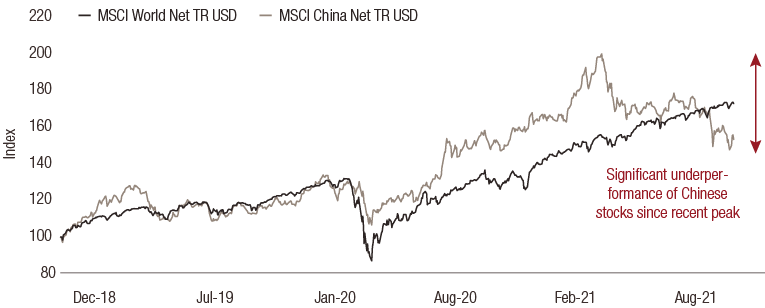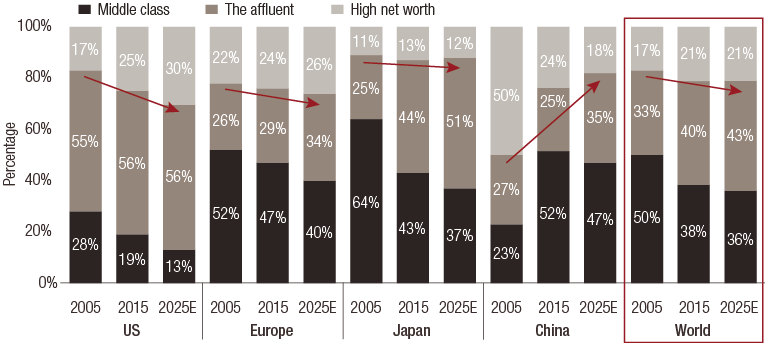investment viewpoints
Will China’s middle class save luxury demand from wealth taxes?




The potential for new redistributive policies in China, in the form of heavier taxes on higher income earners and hikes in capital gains or property taxes, may hit high-net-worth individual (HNWI) consumers. However, in our view, this should not overshadow growing demand for luxury goods from the increasingly wealthy Chinese middle class – enabling sales for high-end brands to remain resilient.
Tech, tutoring – are luxury goods next?
At a finance meeting on 17 August Chinese President Xi Jinping called for a “reasonable adjustment of excessive incomes” and encouraged wealthy groups and businesses to give more to society, according to a Jing Daily report.
This year, Xi has also alluded to the importance of ‘’common prosperity,’’ loosely defined as the creation of more fair and inclusive conditions to expand the middle class and address the nation’s rising income disparities.
Disposable income of people in top fifth of Chinese households is more than 10 times higher than those in the bottom fifth, while disposable incomes in cities are two and a half times those of the countryside, according to The Economist, citing official figures.
The Chinese Communist Party’s (CCP’s) aim of achieving common prosperity can be seen as part of the motivation for the authorities’ regulatory action this year – especially lifting pay and improving conditions for gig-economy workers1. Lowering the income gap between the urban and rural Chinese is also part of the CCP’s current five-year plan.
This focus on the ultra-rich follows the recent regulatory crackdown on the technology and tutoring sectors, which triggered a stock-market sell-off and underscored increasing efforts by the Chinese Government to reimagine the nation’s quality of economic growth in accordance with its own blueprint.
But we believe this short-term volatility should not cloud China’s underlying investment strengths in the long-term. Especially at a time when Chinese stocks have materially underperformed against the global benchmark since their recent peak (see figure 1).
FIG 1. Window of opportunity? Chinese stocks have underperformed recently

China’s appetite for luxury
The Chinese consumer represents about 40% of global demand for luxury goods, according to estimates by Goldman Sachs2. Q2 earnings reports from high-end consumer brands also pointed to strong retail sales in China, given the reduced mobility of Chinese travellers due to the pandemic.
But some investors are reducing exposure amid the perceived risk of luxury-goods demand being undermined by the potential for new policies targeting wealth redistribution. The luxury sector, as indicated by the S&P Global Luxury Index, was down 6.8% in the week of 17 August compared to the -1.9% return of the MSCI World. European luxury brands have been particularly impacted given their broad exposure to China.
Luxury brands’ middle kingdom
The Chinese Government’s rhetoric may be somewhat reminiscent of the Xi-led crackdown on gifting and lavish consumption that started in 2013. That campaign severely impacted the luxury sector, which took three years to recover. But we expect further regulatory moves to be less impactful.
This is because elite brands are less reliant on HNWI demand. They increasingly generate sales from middle-class and affluent consumers, and have attracted more buyers from the millennial and Gen Z demographic cohorts. To broaden their market base, luxury brands have diversified product ranges and pricing structures accordingly, and complemented their presence in Pudong, central Beijing and other retail hotspots by expanding into lower tier cities and selected e-commerce channels.
This has resulted in middle-class consumers providing the most demand for luxury goods in China, followed by the affluent and then the HNWIs – a trend that has persisted since 2015 (see figure 2).
An additional 400 million consumers are expected to transition from low-income to middle- class or higher over the next 10-15 years and domestic tourist, entertainment and duty-free zones like Hainan could bolster additional domestic luxury consumption when borders likely re-open in a year, according to another Jing Daily report.
This supports our view that any potential decline in HNWI demand as a result of any new redistributive policies should not diminish the dominant sources of growth for luxury brands in China: middle class and affluent consumers across the country’s cities.
FIG 2. Tectonic shifts in China’s luxury demand
Source: Goldman Sachs Equity Research. “Luxury outlook and strategy: Evolve or decline - Kering raised to Buy”. Published 26 September 2016.
LOIM’s luxury exposure through World Brands
As a global, high-conviction equity strategy focused on brands positioned to benefit from long-term consumer trends, our World Brands portfolio has an approximate 10% exposure to pure luxury companies (excluding cosmetics, apparel and sporting goods). This is one of the lowest weightings to the sector on a global basis relative to the portfolio’s history. Overall, the strategy is diversified across brands appealing to the appetite for greater sustainability, digitalisation and wellbeing among consumers.
sources
Sub-fund details
Informazioni importanti.
RISERVATO AGLI INVESTITORI PROFESSIONISTI
Il presente documento è stato pubblicato da Lombard Odier Funds (Europe) S.A., una società per azioni di diritto lussemburghese avente sede legale a 291, route d’Arlon, 1150 Lussemburgo, autorizzata e regolamentata dalla CSSF quale Società di gestione ai sensi della direttiva europea 2009/65/CE e successive modifiche e della direttiva europea 2011/61/UE sui gestori di fondi di investimento alternativi (direttiva AIFM). Scopo della Società di gestione è la creazione, promozione, amministrazione, gestione e il marketing di OICVM lussemburghesi ed esteri, fondi d’investimento alternativi ("AIF") e altri fondi regolamentati, strumenti di investimento collettivo e altri strumenti di investimento, nonché l’offerta di servizi di gestione di portafoglio e consulenza per gli investimenti.
Lombard Odier Investment Managers (“LOIM”) è un marchio commerciale.
Questo documento è fornito esclusivamente a scopo informativo e non costituisce un’offerta o una raccomandazione di acquisto o vendita di titoli o servizi. Il presente documento non è destinato a essere distribuito, pubblicato o utilizzato in qualunque giurisdizione in cui tale distribuzione, pubblicazione o utilizzo fossero illeciti. Il presente documento non contiene raccomandazioni o consigli personalizzati e non intende sostituire un'assistenza professionale in materia di investimenti in prodotti finanziari. Prima di effettuare una transazione qualsiasi, l’investitore dovrebbe valutare attentamente se l’operazione è idonea alla propria situazione personale e, ove necessario, richiedere una consulenza professionale indipendente riguardo ai rischi e a eventuali conseguenze legali, normative, creditizie, fiscali e contabili. Il presente documento è proprietà di LOIM ed è rivolto al destinatario esclusivamente per uso personale. Il presente documento non può essere riprodotto (in tutto o in parte), trasmesso, modificato o utilizzato per altri fini senza la previa autorizzazione scritta di LOIM. Questo documento riporta le opinioni di LOIM alla data di pubblicazione.
Né il presente documento né copie di esso possono essere inviati, portati o distribuiti negli Stati Uniti d’America, nei loro territori e domini o in aree soggette alla loro giurisdizione, oppure a o a favore di US Person. A tale proposito, con l’espressione “US Person” s’intende un soggetto avente cittadinanza, nazionalità o residenza negli Stati Uniti d’America, una società di persone costituita o esistente in uno qualsiasi degli stati, dei territori, o dei domini degli Stati Uniti d’America, o una società di capitali disciplinata dalle leggi degli Stati Uniti o di un qualsiasi loro stato, territorio o dominio, o ogni patrimonio o trust il cui reddito sia soggetto alle imposte federali statunitensi, indipendentemente dal luogo di provenienza.
Fonte dei dati: se non indicato diversamente, i dati sono elaborati da LOIM.
Alcune informazioni sono state ottenute da fonti pubbliche ritenute attendibili, ma in assenza di una verifica indipendente non possiamo garantire la loro correttezza e completezza.
I giudizi e le opinioni qui espresse hanno esclusivamente scopo informativo e non costituiscono una raccomandazione di LOIM a comprare, vendere o conservare un titolo. I giudizi e le opinioni sono validi alla data della presentazione, possono essere soggetti a modifiche e non devono essere intesi come una consulenza di investimento. Non dovrebbero essere intesi come una consulenza di investimento.
Il presente documento non può essere (i) riprodotto, fotocopiato o duplicato, in alcuna forma o maniera, né (ii) distribuito a persone che non siano dipendenti, funzionari, amministratori o agenti autorizzati del destinatario, senza il previo consenso di Lombard Odier Funds (Europe) S.A. ©2021 Lombard Odier IM. Tutti i diritti riservati.




